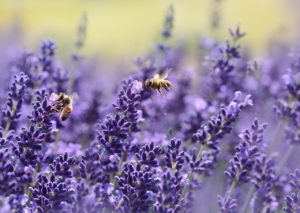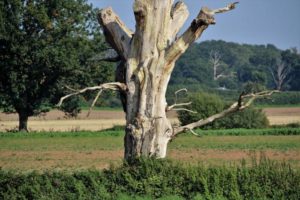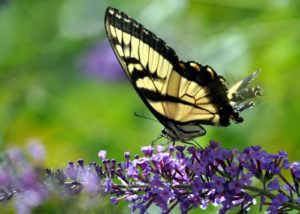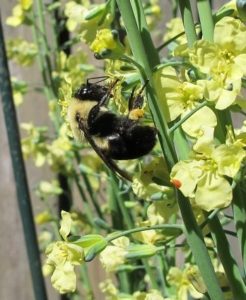Page 2
Planting for Pollinators
If you’re a fortunate gardener with lots of room to plant a diverse mixture of plant life, your garden will attract a wide variety of pollinators. Plant some of the following species and soon you’ll see more activity in your yard. And maybe more apples in the trees. This is a limited list, though.
Contact your local agricultural extension office for more suggestions. Research native species in your region and include many of them in your gardens.
For Bees:
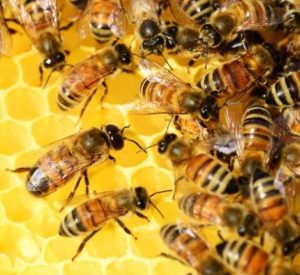
Alyssum, anise, anise hyssop, armeria, aster, basil, black-eyed Susan, blueberries, brassicas, borage, clematis (single flower), cleome, clover, coneflower. Cosmos, crocus, daffodil, dandelion, dianthus, echinops, foxglove, fruit trees, goldenrod, hellebore, hyssop, Joe-pye weed, lavender, mint, monarda, mountain mint. Oregano, poppy, primula, rosemary, sage, sedum, sourwood tree, sunflower (not pollenless varieties), thistle, thyme, Verbena bonariensis, yarrow.
Bees prefer blue, yellow, and white flowers. Honey bees collect pollen on hind legs to take back to the hive.
For Butterflies and Moths, Larvae and/or Adults:
Abelia, alcea, alfalfa, alyssum, apple, ash, aspen, aster, butterfly bush, California lilac, cassia, chokecherry, cilantro, clover, coneflower, cosmos, cottonwood. Daylily, dianthus, elm, goldenrod, grasses, green ash, hackberry, hawthorn, hollyhock, lantana, lavender, liatris, locust, lupine, marigold, milkweed. Monarda, mustard family (brassicas), nasturtium, nettle, oak, pansy, parsley, passion flower, pawpaw, phlox, plantain, poplar, rue, sedum, sheep sorrel, snapdragon. Spicebush, sunflower, sweet bay magnolia, sweet pea, sycamore, thistle, verbena, vetch, viola, wild cherry, wild licorice, willow, zinnia.
For Hummingbirds:
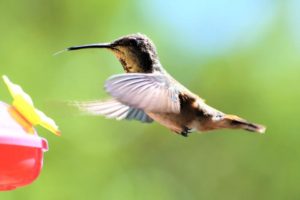 Abelia, abutilon, agastache, basil, bleeding heart, butterfly weed, canna, columbine, cleome, crape myrtle, foxglove, fuchsia, honeysuckle, impatiens, lily, lobelia. Lupine, monarda, nasturtium, penstemon, petunia, phlox, red hot poker, sage, salvia, tecoma.
Abelia, abutilon, agastache, basil, bleeding heart, butterfly weed, canna, columbine, cleome, crape myrtle, foxglove, fuchsia, honeysuckle, impatiens, lily, lobelia. Lupine, monarda, nasturtium, penstemon, petunia, phlox, red hot poker, sage, salvia, tecoma.
Hummingbirds will sip from the feeder you supply. Change the solution and clean the feeder often.
Pollinators In the Landscape
Plant Selection
Grow plants that are appropriate for the conditions you have. If your new house has no landscape yet, and the entire quarter acre basks in hot sun all day, don’t try to grow hostas or foxgloves. Instead, plant sedum, lavender, zinnia, Rudbeckia, and other sun tolerant flowers, until new trees have become established. Expect the character of the landscape to change over the decades.
Several plants massed together in a drift are clearly visible to the pollinators. Large blocks of color will not go unnoticed by the bees and butterflies. Butterflies are more likely to lay eggs on milkweed, for example, if there are 10 plants instead of 2. This reassures Mommy Monarch that there will be enough food for her young caterpillars.
Look for varieties that have single flowers. Hybrids with double or triple rows of petals have fewer nectaries, and, therefore, less nectar and pollen for the pollinators to gather. Consider using more native species, or their nativars, rather than the imported hybrids.
Host Plants and Nectar Plants
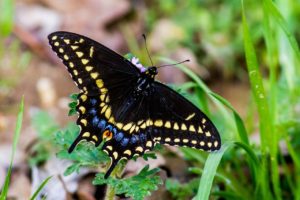
Black swallowtail butterfly.
To encourage populations of butterflies to reside in the area, plant host plants as well as nectar plants. Butterflies are very particular about which plant species they choose to host their young. For example, monarchs lay eggs only on milkweed, which the young caterpillars consume. As adults, however, they feed on nectar from many kinds of plants.
Black swallowtail larvae feed on plants in the Apiaceae family, including parsley, dill, cilantro, and fennel. They, too, are general feeders as adults.
The Importance of Native Plants for Pollinators
Native species of plants, and their varieties (“nativars”), host a great number of indigenous insects and other invertebrates. They also support our native bird populations. Songbirds have suffered a serious decline in number, in many areas to only about half what they were two generations ago. This is due, in part, to loss of habitat, including native tree and shrub canopy, and to wholesale killing of their food sources—the insects.
Native plants support a wide variety of indigenous insects and other organisms. But widespread use of non-native plants and huge lawns rob our native species of their food supply. Use of chemicals also causes a decline in insect populations.
So, as we choose plants for our landscapes, include at least some, but preferably most, native species. This helps maintain the natural food chain, from the insects and other pollinators to spiders, amphibians, reptiles, and birds. This also attracts the hunters that keep the others in check. That’s the balance of nature.
Here’s one way you can gauge the health of your landscape, from the perspective of native insects and animals: see how many kinds of plants have holes in the leaves! Lots of holes or missing leaves indicate an abundance of native species feeding on the plants you provide, and that’s a good thing.
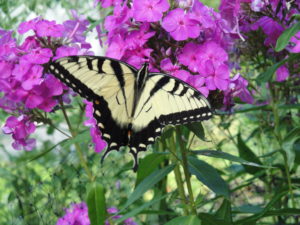
Eastern swallowtail butterfly on perennial phlox.
Water and Minerals
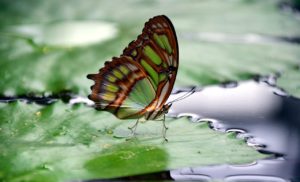
Butterfly on a waterlily pad.
Butterflies, especially the males, enjoy visiting a muddy patch, preferably in the sun, where they sip mineral salts. Large flat rocks invite butterflies to bask in the sun.
A source of water, such as a bird bath or a fountain, is especially welcome on a hot day. Keep water available to the pollinators as long as they’re active. Change the water every 2 or 3 days, so mosquitoes won’t become a problem. Or consider using a piece of a “Mosquito Dunk”, a strain of Bt which prevents mosquitoes from maturing.
Another option is a small pond that provides water for animals and pollinators year-round. Include rock islands and plants so pollinators can safely gain access to the water, and feeder goldfish to eat mosquito larvae.
Shelter
Shelter is another requirement to keep the pollinators happy. Leave a “snag”, or a dead tree, standing, as long as it’s not unsafe. Woodpeckers and other birds will hunt for beetle larvae and other insects burrowing through the wood. Also, birds and some of the pollinators will nest in cavities, where they can raise their young.
Because I’m a “let it be” gardener, I enjoy offering different environments to the animals and letting nature unfold in front of me. I love it all…well, maybe not so much when the owl starts “hoo-hoo-hooting” outside my window at 2:00 in the morning.
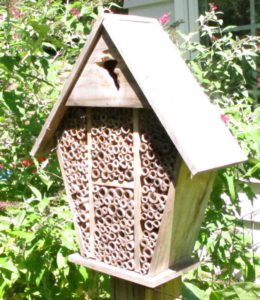
An easily constructed bee house.
Hang nesting boxes for mason bees and other species to establish new populations in your neighborhood. They’re easily constructed from hollow natural bamboo segments nestled in a frame. Another option is to simply drill holes into a short log, roofed or sloped for drainage. Some of the larger bees are excellent pollinators as they vibrate around the flowers.
Hedgerows and mixed shrub borders offer resting places, nesting areas, and shelter from hot sun, predators, or stormy weather. Choose varieties that don’t require shearing.
Yard Litter
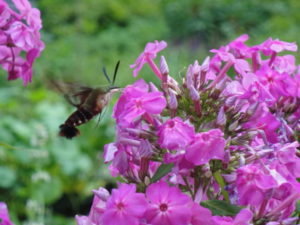
A hummingbird moth on garden phlox.
Leaf litter under shrubs provides habitat for overwintering insect pupae, such as the fascinating hummingbird moths. Ordinarily, we like to tidy up the gardens before the onset of winter. But pollinators prefer more unkempt conditions, where we just “let nature happen”.
Leaves and twigs collected into brush piles attract animals and insects and encourage them to reside on your property year after year. Removing potential nesting and resting sites leads to a more sterile environment. Consequently, we have to wait until spring, when individuals move in and gradually repopulate our gardens.
Gather fallen tree branches, twigs, uprooted annuals, weeds, and leaves into a loose pile. Where I now live in rural North Carolina (since autumn, 2021), a few brush piles provide shelter for overwintering insects and animals, and safe haven for small birds when danger threatens. Wrens, particularly, dart in and out of the brush, looking for a tasty treat.
Attracting Pollinators to Your Garden
If you need pollinator magnets for your vegetable garden, start with ‘African Blue’ basil. Other varieties of basil are better in a salad, but you can’t beat this one for bringing in the bees. This variety, by the way, is sterile. Since it can’t set seed, it keeps trying…and trying…by blooming its head off!
It flowers all summer, right up to frost, and grows 2′ to 3′ tall and a bit wider than that. The leaves are green to purplish, and flowers range from white to purplish. If you want deeper purple flowers, look for plants that have purple leaves and stems. Prune if it grows too large, and take the stems indoors as cut flowers. Plant it near vegetables that need pollinating, such as tomatoes, peppers, and squash.
This is a tender herb, so it does not do well outdoors until the weather has warmed up. Fortunately, basil downy mildew does not affect ‘African Blue’ basil.
More Favorites
Many plants are especially attractive to pollinators in summer and fall gardens. These include butterfly bush (photo, above), anise hyssop, borage, fall-blooming sedums, lavender, mountain mint, and salvias.
Cool-season greens have provided us with edible foliage all through the winter. But, after cutting broccoli side shoots a few times, I let the plants go to flower, around April, for the bees. The welcome flowers of broccoli (photo, right), collards, mustard greens, and kale provide sustenance for these early risers.
Early blooming fruit trees are especially favored by bees.
Spring-flowering bulbs are another welcome source of nutrients for pollinators when little else is in bloom. Daffodils, hyacinths, grape hyacinths, and crocuses are easy to grow, and begin blooming in late winter.
National Pollinator Week
In 2007, legislation put forward by Saxby Chambliss, U.S. Senator from Georgia, establishes one week in June as National Pollinator Week. We need to be aware of how critically important pollinators are to agriculture.
So, how do you plan to celebrate? One option could be to start a new garden. Plant a chemical-free zone, filled with a variety of plants that will attract all sorts of pollinators. Bring in more native plants, and maybe some budding naturalists will follow!
The National Pollinator Garden Network has a goal of registering one million pollinator gardens throughout the country. So far, they have almost 950,000 participants. Check their map to see how many are in your state. Will the next dot on the map be yours? (***Update*** 3/15/2019: now, over 1,040,000 participants!)
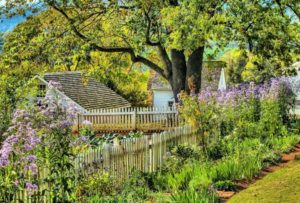
A varied landscape, perfect for all kinds of pollinators. Include different plants that bloom in all seasons of the year, with an emphasis on native plants.
Headings
Page 1: What’s All the Buzz About Pollinators? (The Fruits of Pollination), Honey Bees (Why All the Fuss About Pollinators?, Current Research), and So, What Can We Do About It? (To Spray Or Not To Spray, Try Using These, Bt, Braconid Wasps)
Page 2: Planting for Pollinators (For Bees, For Butterflies and Moths, For Hummingbirds), Pollinators In the Landscape (Plant Selection, Host Plants and Nectar Plants, The Importance of Native Plants for Pollinators, Water and Minerals, Shelter), Attracting Pollinators to Your Garden, and National Pollinator Week
